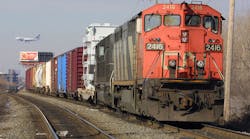Latest from Economic Data
New Data for Electrical Product Sales Estimates
The rails speak: Slight YOY gains in 2017 economy. Weekly U.S. freight rail traffic, a leading economic indicator, is showing some slight gains year-over-year gains, according to the Association of American Railroads (AAR), (www.aar.org), Washington, DC.
For the week ending Nov. 11, total U.S. weekly rail traffic was 547,480 carloads and intermodal units (the containers that are transferred to trucks) were up 1.2% compared with the same week last year. Total carloads for the week ending No. 11 were 263,265 carloads, down 3.3% compared with the same week in 2016. For the first 45 weeks of 2017, U.S. railroads reported cumulative volume of 11,702,354 carloads, up 3.1% from the same point last year.
Purchasing Managers Index dips 1.2 points in October but still reflects bullish buying climate. The Institute for Supply Management’s October PMI dropped to 58.7% from the September reading of 60.8% but industrial purchasing managers surveyed for the monthly report are still quite optimistic. Timothy Fiore, chair of the ISM Manufacturing Business Survey Committee said in a press release, “Comments from the panel reflect expanding business conditions, with new orders, production, employment, order backlogs and export orders all continuing to grow in October, supplier deliveries continuing to slow (improving) and inventories contracting during the period.”
Hurricanes knock down Conference Board’s Leading Economic Index (LEI) for the U.S. The U.S. LEI declined -0.2% in September to 128.6 (2010 = 100), following a +0.4% increase in August, and a -0.3% increase in July. “The U.S. LEI declined slightly in September for the first time in the last twelve months, partly a result of the temporary impact of the recent hurricanes,” said Ataman Ozyildirim, the Conference Board’s director of business cycles and growth research, in a press release. “The source of weakness was concentrated in labor markets and residential construction, while the majority of the LEI components continued to contribute positively. Despite September’s decline, the trend in the US LEI remains consistent with continuing solid growth in the US economy for the second half of the year.”








